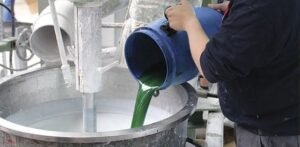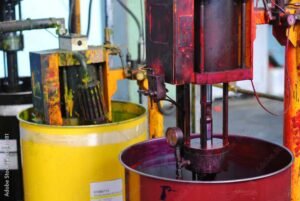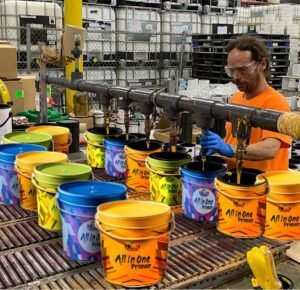Introduction to the Paints Manufacturing Industry in Pune
The paints manufacturing industry represents a vital segment of the broader manufacturing sector, playing a significant role in both economic growth and technological innovation. Characterized by diverse production lines, this industry churns out a variety of paints to meet distinct market demands. Broadly, these fall into three primary categories: decorative paints, industrial paints, and automotive paints. Each type of paint serves unique functions—decorative paints for aesthetic enhancement and protective coatings in residential and commercial buildings, industrial paints for machinery, infrastructure, and specialty applications, and automotive paints designed to protect and beautify vehicles.
The production of paints involves a complex interplay of raw materials and processes. Key ingredients include pigments for color, binders to hold the pigment particles together, solvents to maintain the mixture’s consistency, and additives to impart specific properties. The manufacturing process typically consists of stages such as pre-mixing, dispersion, and stabilization, eventually leading to the packaging of the finished product. These manufacturing processes benefit from continuous advancements in chemistry and material sciences, ensuring the production of high-quality and eco-friendly paints.
Globally, the paints manufacturing industry is subject to rigorous regulatory standards and evolving consumer preferences. Environmental considerations and the demand for sustainable products have spurred significant innovation. In this global context, India’s burgeoning market plays a pivotal role, buoyed by rapid urbanization, expanding infrastructure projects, and rising consumer prosperity. As such, the paints manufacturing industry in India is thriving, contributing substantially to the nation’s economic landscape.
Narrowing down to the specific relevance in India, Pune has emerged as a notable hub within this sector. The city benefits from a robust industrial ecosystem, strategic location, and significant investments in research and development, positioning it as a critical center for paints manufacturing. Pune’s prominence in this industry is further supported by a skilled workforce and excellent logistical connectivity, aligning seamlessly with the broader ambitions of the Indian manufacturing sector.

Historical Development of the Paints Industry in Pune
The paints manufacturing industry in Pune has a rich history, spanning several decades of growth and transformation. Emerging initially as a modest sector, the industry has evolved remarkably since its inception. The roots of paints manufacturing in Pune can be traced back to the mid-20th century when small-scale units set up operations to fulfill local demand. These early efforts were characterized by traditional methods, focusing on basic formulations and limited product ranges.
One of the significant milestones in the industry’s history was the establishment of pioneering companies that saw potential in Pune’s strategic location and burgeoning market. Companies such as Asian Paints and Berger Paints set up extensive manufacturing facilities, leveraging Pune’s robust infrastructure and proximity to raw material suppliers. Their arrival marked the beginning of a more structured approach to production, laying a strong foundation for future growth.
As the industry matured, significant technological advancements played a crucial role in transforming the manufacturing processes. The 1980s and 1990s witnessed a shift from manual techniques to semi-automated systems, enhancing efficiency and product consistency. The adoption of state-of-the-art machinery and adherence to international quality standards further bolstered Pune’s reputation as a key hub for paints manufacturing. Companies invested heavily in research and development, introducing innovative products such as eco-friendly paints and high-performance coatings.
In recent decades, the integration of digital technologies has revolutionized the industry even further. Automation, IoT (Internet of Things), and advanced analytics have streamlined operations, ensuring optimal utilization of resources and minimizing waste. These advancements have not only improved production capacities but also aligned the industry with global environmental and safety standards.
Today, Pune’s paints manufacturing industry stands as a testament to decades of resilience and adaptation. The confluence of traditional craftsmanship and modern technology positions Pune as a significant player in the global paints market. The city’s ability to evolve and innovate continues to drive its success and promises a bright future for the paints manufacturing industry.

Technological Advancements and Innovations
The paints manufacturing industry in Pune has witnessed significant technological advancements driving both efficiency and sustainability. These technological strides are multifaceted, spanning production techniques, automation, quality control, and sustainable practices. One notable area of innovation is in production techniques. Pune-based companies have integrated state-of-the-art machinery capable of creating more uniform and high-quality paints. These machines include advanced mixers and dispersers that ensure better consistency and stability in paint formulations, thereby elevating product quality.
Automation stands as another monumental improvement in the paints manufacturing sector. Automated systems are now prevalent in several Pune-based factories, significantly reducing human error and increasing production speed. For example, robotic arms equipped with sophisticated sensors can handle tasks ranging from raw material handling to packaging, ensuring a seamless production process. This elevation in automation not only accelerates production timelines but also improves the precision and uniformity of the finished products.
Quality control technologies have evolved dramatically, allowing manufacturers in Pune to implement sophisticated monitoring systems. These systems utilize AI and machine learning algorithms to predict and rectify issues in real-time during the production process. By doing so, the likelihood of defects is minimized, ensuring that the final product meets or exceeds quality standards. For instance, spectrophotometers and other advanced analytical devices are used extensively to monitor color consistency and pigment dispersion accurately.
Sustainability has also become a pivotal focus in the paints manufacturing industry. Pune-based companies are increasingly adopting eco-friendly practices such as water-based and low-VOC (volatile organic compounds) paints, which reduce environmental impact. Moreover, technological advancements have facilitated the development of recycling systems within the manufacturing units, allowing for the reuse of waste products and reducing overall waste generation. Additionally, innovations in energy-efficient machinery reduce the carbon footprint of paint manufacturing processes.
Overall, these technological advancements have collectively revolutionized the paints manufacturing industry in Pune. Through innovative production techniques, automation, enhanced quality control, and sustainability practices, local companies are leading the way in delivering high-quality, eco-friendly products while streamlining their manufacturing processes.

Raw Material Sourcing and Supply Chain Management
In the paint manufacturing industry, the procurement of raw materials is fundamental to the production process. In Pune, manufacturers rely on a diverse range of raw materials, including pigments, solvents, resins, and additives. These components form the backbone of the paint production cycle and must be sourced with a commitment to both quality and sustainability.
Pigments, which provide the color in paints, are sourced from various suppliers, and can be either natural or synthetic. Local sourcing of pigments is often preferred to minimize costs and ensure timely deliveries. However, certain high-quality pigments are imported to meet specific industry standards and customer requirements. Solvents, essential for dissolving and dispersing the pigments, are also critically sourced. The supply chain for solvents often involves both local chemical industries and international suppliers, ensuring a blend of quality and cost-efficiency.
Resins, which act as the binding agent, play a critical role in determining the durability and performance of the paint. These are predominantly sourced from established chemical manufacturers within India but may also be supplemented with imports to achieve specific formulation needs. Additives, though used in smaller quantities, are vital for enhancing the paint’s properties such as durability, viscosity, and drying time. These additives often come from niche suppliers who specialize in chemical manufacturing.
Managing the supply chain in the paint manufacturing sector involves navigating numerous challenges. Manufacturers in Pune face issues such as fluctuating raw material prices, regulatory hurdles, and logistical constraints. Establishing robust partnerships with reliable suppliers is essential to mitigate these risks. For instance, many manufacturers have formed strategic alliances with local chemical producers and global suppliers to ensure a steady and consistent supply of high-quality raw materials.
The balance between local and imported raw materials is a crucial aspect of supply chain management. While local sourcing helps reduce lead times and transportation costs, imported materials often provide superior quality or unique properties that are not available locally. Thus, a hybrid approach is usually adopted to optimize the benefits of both local and international sourcing.

Regulatory Environment and Compliance
The paints manufacturing industry in Pune operates within a comprehensive regulatory landscape designed to promote safety, environmental sustainability, and quality standards in manufacturing processes. Key regulations governing the sector include national directives from the Bureau of Indian Standards (BIS) and local mandates from the Maharashtra Pollution Control Board (MPCB). The BIS sets forth manufacturing standards that ensure the safety and efficiency of processes, while the MPCB enforces stringent environmental compliance guidelines to mitigate pollution.
Environmental compliance is a primary concern for the industry, given the significant use of chemicals in paint production. Companies are required to adhere to the Environmental Protection Act, 1986, which mandates the treatment of effluents and the safe disposal of hazardous waste. Regular audits by MPCB ensure that manufacturers employ eco-friendly practices such as using low volatile organic compounds (VOC) paints and incorporating wastewater treatment plants within their facilities.
In addition to environmental regulations, safety norms play a crucial role in the paints manufacturing industry. The Factories Act, 1948, stipulates numerous safety protocols, from the proper storage of raw materials to the implementation of fire safety measures. Training programs on the proper handling of hazardous chemicals are another essential compliance requirement, helping to prevent accidents and ensure worker safety. These measures are often subject to random inspections by the Directorate of Industrial Safety and Health (DISH).
Recent regulatory changes have further impacted the industry. Amendments to the Hazardous and Other Wastes (Management and Transboundary Movement) Rules, 2016, have introduced more stringent requirements for the management and tracking of hazardous waste. Additionally, updates to the Air (Prevention and Control of Pollution) Act, 1981, have emphasized the reduction of harmful paint fumes, pushing companies to innovate with greener production methods.
To navigate these regulations efficiently, companies in Pune’s paints manufacturing sector typically employ compliance officers and maintain robust regulatory affairs departments. These teams ensure continuous monitoring and adherence to evolving standards, thus sustaining operational stability and contributing to the responsible growth of the industry.
Market Trends and Consumer Preferences
The paints manufacturing industry in Pune is presently navigating an era marked by dynamic shifts in market trends and evolving consumer preferences. Central to these changes is an amplified demand for eco-friendly paint products. As environmental consciousness grows among consumers, manufacturers are compelled to innovate, developing paints that are not only aesthetically pleasing but also environmentally sustainable. This trend aligns with a broader, global movement emphasizing the reduction of volatile organic compounds (VOCs) and promoting the utilization of natural and biodegradable materials.
In tandem with the greening of paint products, there is a notable surge in the preference for customized and personalized color solutions. Consumers in Pune are progressively seeking unique hues that resonate personally, thereby pushing companies to offer bespoke mixing services and expansive color palettes. Digital tools and mobile applications are become pivotal in aiding consumers to visualize potential color schemes, thus enhancing the decision-making process through virtual simulation of painted spaces, catering to the trend of customization.
Color trends themselves are witnessing shifts, with a growing inclination towards muted and pastel shades, reflecting a move towards minimalism and tranquility in interior designs. Nonetheless, vibrant and bold colors remain favorites for accenting, endorsement of dynamic, lively spaces. This dual dynamism in color preferences challenges manufacturers to sustain a versatile range to meet diverse consumer tastes.
In response to these market trends, paints manufacturing companies in Pune are adopting multifaceted strategies to retain a competitive edge. Innovations in product formulations to develop low-VOC and water-based paints underline efforts to meet eco-friendly demands. Additionally, marketing strategies increasingly leverage sustainability credentials, with companies emphasizing the long-term environmental benefits of their products in their campaigns. Collaborative initiatives with designers and influencers are also prevalent, aimed at aligning products with contemporary aesthetic sensibilities, which proves instrumental in capturing the attention of style-conscious consumers.
Overall, the convergence of ecological awareness, personalized color preferences, and advanced marketing strategies delineates the contemporary landscape of the paints manufacturing industry in Pune. Companies that adeptly navigate these trends through innovation and consumer engagement are poised to thrive in this evolving market.

Challenges and Future Outlook
The paints manufacturing industry in Pune faces a complex landscape marked by both challenges and opportunities. One of the primary challenges is intense competition both from local and international players. Established brands are continually innovating, and new entries in the market are pushing for a share, which forces manufacturers to invest heavily in research and development, driving up operational costs.
Another significant challenge is the volatility in raw material prices. Many of the raw materials used in paints manufacture are derivatives of petrochemicals, which are subject to volatile price fluctuations due to changes in crude oil prices. This unpredictability affects profit margins and adds a layer of financial risk for manufacturers. Navigating these fluctuations requires strategic procurement and maintaining buffer stock, which also ties up capital.
Environmental concerns also play a critical role in shaping the industry. The push for sustainable and eco-friendly products means manufacturers must invest in developing green technologies and comply with stringent environmental regulations. This transition can be costly and time-consuming but opens new market segments focused on sustainable living. Manufacturers are increasingly adopting water-based paints and exploring alternative raw materials that have a lower environmental impact.
Economic factors such as inflation, fluctuating currency exchange rates, and varying consumption demand further complicate the business environment. Local economic slowdowns can reduce consumer spending on non-essential goods like paints, whereas favorable economic conditions can spur growth.
To navigate these challenges, experts suggest implementing strategies that include investing in advanced technologies to enhance operational efficiency and sustainability. Diversifying the supply chain to mitigate raw material price risks and focusing on niche markets like eco-friendly paints can also offer a competitive edge. Embracing digital transformation through e-commerce platforms and digital marketing can help manufacturers reach a broader audience more cost-effectively.
The future outlook for the paints manufacturing industry in Pune remains cautiously optimistic. Ongoing urbanization and infrastructure development provide a steady demand for paints and coatings. As technological advancements continue to make eco-friendly options more feasible, there is an opportunity for significant growth within this segment. While challenges persist, strategic planning and adaptation will be key to leveraging emerging opportunities in this dynamic market.

